
As we head toward the conclusion of another academic year, it’s important to take... Read More about Listening Tour Offers Opportunity to Discuss Vision for Success

Even for Orange Coast College’s brightest STEM students, the math will never make sense.
The average one-bedroom apartment rental goes for $1,829 in Costa Mesa, California, according to RentCafe.com. That’s in addition to an average tuition cost of $7,670 – not to mention rising rates for books, transportation, food, health care and school supplies. For the estimated 49 percent of community college students facing some form of housing insecurity in California, it just doesn’t add up.
“There’s a need,” says Orange Coast College Director of Marketing and Public Relations Juan Gutierrez. “We listen to our students… and this has popped up for years – it’s difficult for our students to afford to rent apartments.”
The housing crisis is real in California, with an estimated 14 percent of community college students experiencing homelessness, and another 35 percent affected directly by housing insecurity. Especially vulnerable are traditionally underserved populations like veterans, former foster youth and single parents, as rising costs of rental units in places like Orange County and the Bay Area place further burden on already-stressed student budgets.
“The lack of housing supply for all Californians, including students and young professionals, has been years in the making,” says Evan Gerberding, deputy director of communications for the Department of Housing and Community Development (HCD). “Skyrocketing rents and home prices [have] created heavy, overwhelming cost burdens on renters and homeowners.”
Material hardships, such as housing insecurity, have a demonstrable effect on college completion, not only attributable to a lack of resources, but also to added stress, postponed medical care, or neglect of social and nutritional habits. And it’s not a “niche” issue. A recent survey of California community colleges found that 56.8 percent of respondents had direct contact with students experiencing basic needs insecurity multiple times per week or every day.
With the future of California’s families and workforce at stake, two-year institutions like Orange Coast College (OCC) are rising to the challenge. In October, OCC made plans to become the first Southern California community college to provide student housing, announcing a 323-unit, $83-million construction project, which more than 800 students will call home starting in fall 2020. The project, launched early October, came in response to critical demand for affordable housing in the notable pricy real estate market of Orange County.
“We surmised that if we put this together, it would be something that students would be very interested in,” says Gutierrez, whose institution will become just the 12th community college in California’s 115-college system to offer on-campus or campus-adjacent housing. “It’s been universally well-received.”
Orange Coast College’s privately funded student housing effort represents a new approach to an issue that urban colleges have long struggled to address. With no control over rental markets, and limited space and resources for college-supplied solutions, these institutions have tended to focus on the student support and advocacy side, providing basic needs referrals, support in seeking subsidized housing, and access to AB 801-mandated resources.
But colleges like OCC are trying to do more. With rental markets continuing to tighten in San Diego, Orange County, Los Angeles, Silicon Valley and the Bay Area, the need for more groundbreaking solutions has emerged.
“If colleges have the foresight, funding and wherewithal, they’re going to start doing more of this on-campus housing,” says Gutierrez.
Prior to OCC’s pioneering project, on-campus housing tended to be the realm of the rural community college. Currently, all 11 two-year institutions offering student housing in California are located in the northern half of the state, with all but two serving communities of fewer than 30,000 people. Before, the “housing crisis” was a matter of supply – smaller communities simply didn’t have the single-unit accommodations to meet student needs. Now, it’s an issue of demand – the units are there, but college-aged adults are being priced out.
“In rural areas, where the housing isn’t there, the colleges just have to create those resources,” says Gutierrez. “In urban areas, it’s a different issue… the high rents.”
For colleges like Sierra and Shasta – located in Rocklin and Redding, respectively – the need for student housing has persisted, even as their communities have transcended the “rural” moniker, and grown into 50,000-plus population cities in their own right. Sierra College, in particular, with its proximity to the exploding real estate market in the Greater Sacramento region, has seen its 1969 decision to construct student housing rewarded.
Currently, Sierra College provides accommodations for 144 students in its two dormitory buildings, with plans to expand into nearby parcels in the coming years.
“In my recollection, we have always had a waiting list,” says Sierra College’s Jeannette Bischoff. “For many students, just getting to campus is a challenge.
“We feel on-campus housing is critical due to the lack of adequate and affordable housing options for students.”
Adding to the housing crisis is the prevalence of wildfire damage in college communities like Shasta, Santa Rosa, Moorpark and Butte. With entire towns in ruins, and families scrambling for housing solutions in an already-stressed market, options for low-cost housing is expected to be all the more scarce. According to the Department of Housing and Community Development, the wildfires are exposing a long-standing deficiency of planning in California.
“For decades, California has been underbuilding homes—especially multifamily housing,” says Gerberding. “This underproduction and tight supply only compounds the challenges to bounce back from multiple disasters, including the tragic wildfires that have been so prevalent in our state.”
But solutions are on the way, says Gerberding.
“After the passage of last year’s landmark housing package, and the success of Props 1 and 2 on the November ballot, we are hoping to turn the tide on our housing crisis and provide a safe, stable, affordable place to call home for every Californian.”

As we head toward the conclusion of another academic year, it’s important to take... Read More about Listening Tour Offers Opportunity to Discuss Vision for Success

Contact your legislators! That’s the message the California Community Colleges... Read More about More Financial Aid for California Community College Students Must Not Wait and You Can Help!

In March “I Can Afford College” launched two in a series of six digital-first... Read More about “I Can Afford College” Campaign’s New Latinx Youth YouTube Series